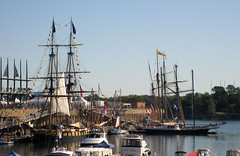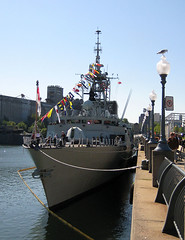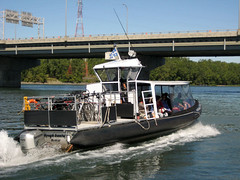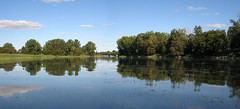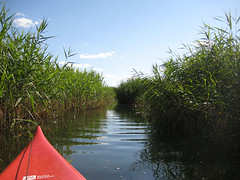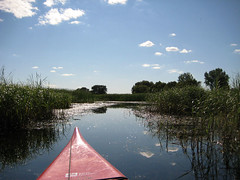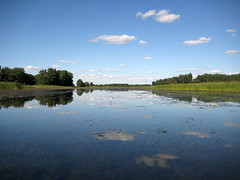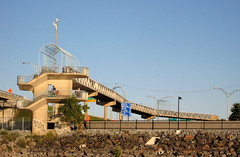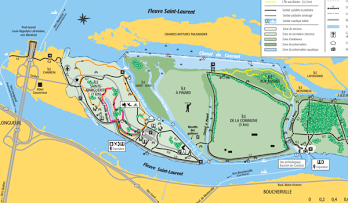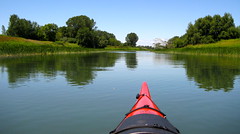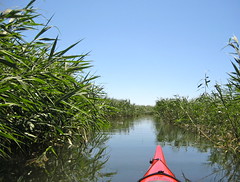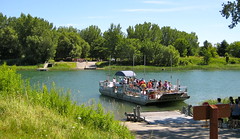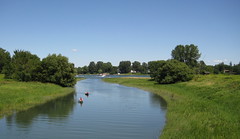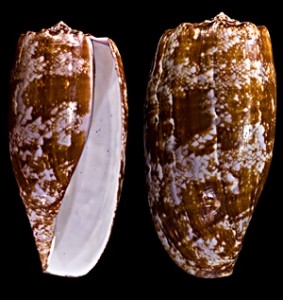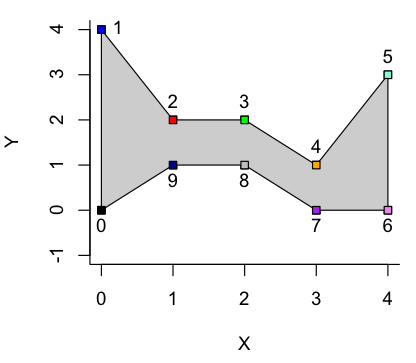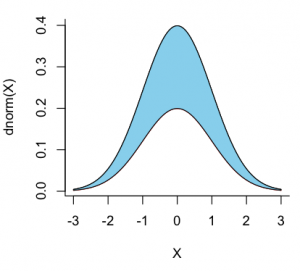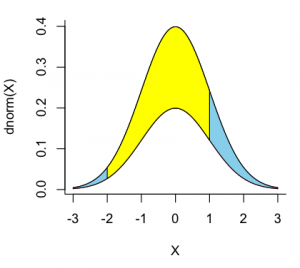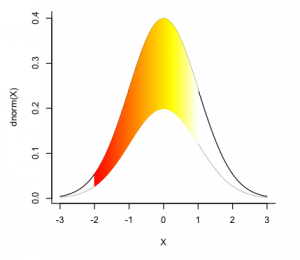Cross-posted from Kayak Yak Yak.
September 18, 2011
So, on paper (on screen), the itinerary looked awful, despite my having the tolerance for lousy connections that comes with being a hardened veteran of public transit. As of Labour Day weekend, only one of the four navettes to Parc des Îles de Boucherville is still ferrying. The (hourly from 1000) ferry leaves on the hour. The (hourly) Sunday bus to the ferry arrives at the nearest stop 2 minutes to the hour, with a long, high footbridge over the highway between stop and dock. On the way back, the (hourly until 1730) ferry leaves the island at half past the hour. The (hourly) bus leaves the stop near the dock about 28 minutes past the hour. Added to that, this ferry pulls in at a jetty on Île Charron an extra 1 km of path away from the kayak rental.
But it was an ideal kayaking day, and I live in the neighbourhood of a stadium. The morning of a big game usually features successive serenades by tow trucks, brass bands (though I harbour a secret pleasure at the irreverence of the Pink Panther at 9 am on the sabbath), and vocals (“Oh Ceh-neh-deh!”). There should be a fine for amplifying any singer who cannot. Hit. That. High. Note. On. Key. I had been out at Parc de la Riviere (I will find that grave accent on the keyboard yet) the previous Sunday and spent 7 hours in a kayak (probably qualifying as one of my 5 longest paddles), so I decided I would head for the ferry.
Leg one of the Great Trek was by Bixi down to the Old Port, which I found busy for a Sunday forenoon, having forgotten the tall ships had sailed into Montréal on Thursday. Four were still in dock, and I paused to take a photo and then carried on west along the promenade. The next nautical attraction was not one to pass with a mere snapshot: frigate HMCS Montréal moored with pennants flying and gangplank down. I found a dock for the Bixi and trotted aboard for a good peer at the ship and all its gear (at least the gear they were willing to show off). Since kayaking leaves one very aware of stability, I am still baffled as to how they launch their Sea-Sparrow missiles without, well, turning over. The angle of the harpoon anti-ship missiles made sense, in that when the rig is in launch position the thrust must be towards the middle of the ship, but the Sea-Sparrows are housed laterally and appear to launch vertically. Must read up.
Around 11:30 I collected my Bixi again (same bike), and set off for Parc Jean Drapeau, which involves describing a big hairpin to come at the Parc via Pont de la Concorde. I had to make Metro Longuiel-Université de Sherbrooke by 41 minutes past the hour to catch the 81 bus – the bus that would probably arrive in time for me to miss the ferry. I continued at my own pace, pausing to take a couple of pictures from the other side of the harbour, and rolled up to the Bixi station beside the Metro at Parc Jean Drapeau at 12:20. Lots of open docks, check. None of which were willing to accept my bike. Finally, after I had tried every dock at least once, one grudgingly gave me the green light, and freed me to plunge down the stairs into the metro station. . . . As the masses began pouring out, a outbound train having come and gone.
So there went another 5 minutes. I rode 1 stop under the river, got off the train and scampered. Well, proceeded on impulse power. Seemed silly to miss the bus now. The bus complex has big windows onto the bus parking area, so you can see your bus on approach, and know when to engage warp engines. I caught the bus, 12:41. Along with a little tot whose mother – who looked about thirteen years old – would never lose her in the long grass. Or, indeed, anywhere short of a rock concert.
The bus hit its mark at the appointed time, and I scurried for the footbridge. From the footbridge, I saw the ferry below at its dock, with a line of people with bikes, loading. Scurry faster. Down stairs, along a few dozen yards, skid down gravel path, and arrive to find that they were full and had to come back for myself and another couple. Which they promised to do. So we hung out on the docks, bobbing as the speedboats tore past, and 10 minutes later, back came the ferry. We’d loaded and cast off when a young family, complete with tot (silent tot) in trailer bike, pulled up, and our captain looped back to collect them. With that and a couple more strays, we had a full cargo of people and bikes.
It’s a quick trip, just across the narrow strip of the St Laurent between Îles de Boucherville and Boucherville. We offloaded adjacent to a boat ramp that was already stacked with boat trailers depositing boats. Once again, I was the only bikeless passenger, and was shortly all alone (but for a few assorted butterflies), tramping around the opening of the highway tunnel (I’m sorry, it is just so wrong to have a 4-lane highway come up from the underworld on an island which is a park). Across Île Charron on the way to the entrance of the park, and down the south side of Île Sainte-Marguerite. I estimated it would take me close to an hour, and it did, though I was not hurrying. Temperature was probably close to 20C, but the air was so clear that the sun had a Calgary feel to it, hot. There was a constant silver noise of cicadas.
I reached the location d’embarcations about 1:40, and paused for a quick lunch before getting to the point of the day. No queue, no crowd on the beach, quite a contrast to my first trip. Red Kayak, Ookpik, with a rudder I never did get to cooperate with me, fixed unfeathered paddle, which felt too short until I was in the reeds. I calculated I had about 2 hours before I would have to make tracks for the dock, because if I missed the 1730 ferry my options would be (a) hitch a lift, (b) call for a taxi, or (c) check into the hotel on the island until next Saturday. I had no desire to fight with criss-crossing wakes, even if there was no wind to speak of, so I turned left/north/up La Grande Riviere and, well, the pictures speak for themselves. Blue sky, round little decorative clouds, and water like glass. I threaded through the reeds for most of the way along the north leg in Chenal le Courant before I hit my turnaround time. There were a few close encounters with fellow paddlers and canoeists in the narrow channels. Canadian politeness seemed to make us compete as to who could move furthest out of the way, leaving 2 boats discretely trying to extricate themselves. Two herons, on the wing, and what I suspect was a kingfisher, with a striking white stripe on the neck. In the photos, the water looks faintly marbled from the weeds, visible through the clear water. An abundance of tiny fish in the shallow waters of Grande Riviere, and some larger ones in the deeper open areas of Chenal le Courant.
Back to the rental, park boat, deliver gear, collect ID, take a couple more photos, knowing I would probably not make another trip before the ferry stopped running after Thanksgiving weekend. Paths were busier on the way back, but still not nearly as busy as they were in July. Arrived at ferry dock about 5 pm, thinking I might be lucky, and they might be shuttling passengers at need, but there was no sign of the ferry. I sat and and watched the antics at the adjacent boat ramp, with boats ringed around the ramp and cars and trucks with trailers queued back along the road waiting to pick up or offload. I’d thought the ferry might be full, which was the other impetus for getting back early, but when we left, we had about eight aboard, including a flushed couple of cyclists who had done a very fast final km. By the time I reached the bus stop in the shadow of the bridge, I was looking at a 50 min wait.
I started walking, along Boulevard Marie-Victorin, with road and humming highway between me and the water, and standard suburbia on the other side. My knees had been wingeing ever since I got out of the kayak, and they stepped up their complaints as the road opened out before me, though it was the low sun in my eyes that eventually made me decide just to stake my spot in a shaded bus shelter, and wait. I detoured via a Macs for a bottle of gatorade and a chocolate bar. Call it rehydration and replenishing glycogen stores, ok? And settled down to read “Sheepfarmer’s Daughter” (Elizabeth Moon) from the Baen Free Library on my iPod touch until the bus came.
Bus to Metro Longuiel-Université de Sherbrooke, Yellow line to Berri-UQUAM, Orange to Metro Sherbrooke, and La Popessa spaghetti house for fettucini a l’Atlantique, which seemed appropriate. So in summary, I kayaked for 2 hours. Biked for probably 2 hours. Walked for 2.5 hours (not counting the time spent aboard HMCS Montréal). Rode various forms of public transit for another hour or so. Definitely did not fulfil Alison’s optimum of paddling time > travel time. But I was lucky on the way out, and psychologically prepared for the return, the sky was blue, there was no wind, and the water was like glass . . . [Edited September 22 to add some more photos]

